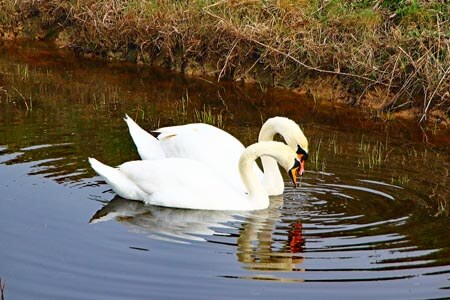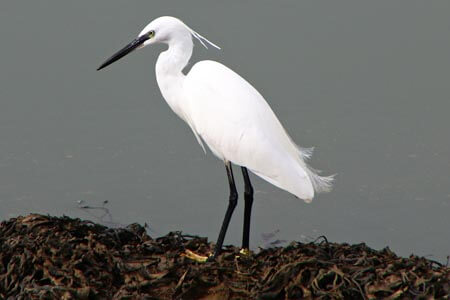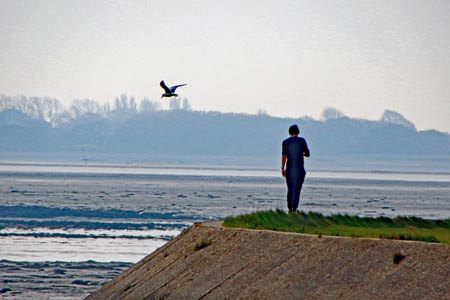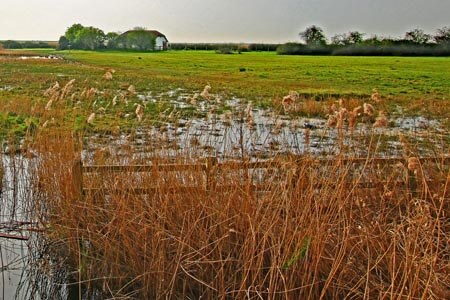Farlington Marshes Nature Reserve - Portsmouth

Located between the A27 Havant by-pass and Langstone Harbour, near Portsmouth, is the Farlington Marshes Nature Reserve, a a 123 hectares Site of Special Scientific Interest and Nature Conservation Review site. Farlington Marshes is a great place to walk and spot birds as this marshy, shoreline reserve is home to a wide range of wildfowl, depending on the time of year. The reserve is owned by Portsmouth City Council and managed by the Hampshire and Isle of Wight Wildlife Trust.
The land at Farlington Marshes was reclaimed from the sea during the 1770's and consists of both fresh water marshland and brackish marsh, both important habitats for resident and overwintering birds.
It is believed the the land reclamation was undertaken for the production of salt or for the hunting of wildfowl, but this is not certain.
The reserve features a mix of grazing marsh, reedbeds, saltmarsh, and lagoon habitats, supporting a rich diversity of wildlife. It’s particularly famous for its birdlife, attracting thousands of migratory birds throughout the year. In the winter months, you can spot large flocks of Brent geese, wigeons, teals, and pintails, while in the summer, the marshes are alive with wading birds like redshanks, lapwings, and avocets. Bearded tits, warblers, and even the occasional short-eared owl can also be seen.
Farlington Marshes is equally valuable for its plant life, with rare species like sea barley and glasswort thriving in the saltmarsh areas. The site’s grazing cattle help maintain the diverse habitats, ensuring the marshes remain rich in flora and fauna.
Although the majority of the nature reserve in on the southern side of the A27, there is a second smaller site to the north, accessed by an underpass, which is home to a variety of ponds and wetland areas.
There are a variety of walks around and through Farlington Marshes, the main route follows the path around the seawall which follows the perimeter of the site this is approximately 2.7 miles and takes around 1¼ hours. Although fairly flat this path is not wheelchair accessible. There are other paths which take you across the marshes and fields, when using these you must stay within the marked areas to avoid disturbing the wildlife. Additionally dogs must always be kept on their leads.
Farlington Marshes includes a few small islands within its network of lagoons and saltmarshes. These islands are primarily natural features created by tidal movements and are important for wildlife conservation. They serve as safe nesting and roosting sites for a variety of wading birds and waterfowl, offering protection from predators and human disturbance.
The islands are especially valuable for species like avocets, redshanks, and lapwings, which use them during the breeding season. In the winter months, they provide resting spots for large flocks of Brent geese, wigeons, and other migratory birds. The islands, along with the surrounding lagoons and saltmarsh, create a dynamic and diverse habitat that supports the rich biodiversity Farlington Marshes is known for.
While the islands themselves aren’t accessible to visitors, they can be viewed from the walking trails and bird hides around the reserve, making them a popular focus for birdwatchers and photographers.
Birds at Farlington Marshes
The wildfowl that can be seen at the site depends on the time of year and the migratory and breeding patterns of the visiting birds, but the following are regular visitors:

- Avocet
- Bearded Tit
- Black-tailed Godwit
- Common Tern
- Cetti's Warbler
- Curlew
- Dark-bellied Brent Geese
- Dunlin
- Golden Plover
- Grey Plover
- Kestrel
- Lapwing
- Little Tern
- Marsh Harrier
- Oystercatcher
- Peregrine Falcon
- Pintail
- Redshank
- Reed Bunting
- Shoveler
- Short-eared Owl
- Stonechat
- Teal
- Wigeon
The history of Farlington Marshes.
Farlington Marshes has a rich history tied to both natural development and human influence, shaping it into the important nature reserve it is today.
Early History and Natural Formation
The marshes are part of the larger Langstone Harbour coastal ecosystem, which has evolved over thousands of years due to natural tidal processes. The area originally consisted of intertidal mudflats, saltmarshes, and grazing marshes, providing a vital habitat for a wide range of wildlife, especially migratory birds.
Agricultural Use
For much of its history, Farlington Marshes were used for agriculture, particularly as grazing land for livestock. The saltmarsh and surrounding areas were traditionally managed as pasture, with cattle and sheep grazing helping to maintain the open landscape and prevent scrub overgrowth. This grazing continues today as part of the conservation management strategy to maintain biodiversity.
World War II Significance
During the Blitz in the Second World War, Farlington Marshes was used as a "Special Fire" or "Starfish Site" used as decoy to lure German bomber aircraft away from their intended targets at Portsmouth. As you approach the reserve from the car park you can still see one of the blockhouses used to control this activity.
Post-War Conservation Efforts
After the war, the importance of Farlington Marshes as a wildlife habitat became increasingly recognised. In 1962, it was designated as a nature reserve and has since been managed by the Hampshire and Isle of Wight Wildlife Trust. Conservation efforts focused on preserving its rich biodiversity, particularly for migratory birds and rare plant species.
The reserve is now part of the Langstone Harbour Site of Special Scientific Interest (SSSI), a Ramsar site (an internationally important wetland), and a Special Protection Area (SPA) under EU conservation laws. These designations highlight its global ecological importance, especially as a haven for wintering Brent geese and other wading birds.
Modern Use and Ecological Importance
Today, Farlington Marshes is a thriving nature reserve, balancing public access with wildlife conservation. It’s a favourite spot for birdwatchers, walkers, and nature enthusiasts, offering a peaceful escape just outside of Portsmouth. The marshes continue to be managed through controlled grazing and habitat maintenance, ensuring that the area remains a vital sanctuary for both wildlife and future generations of visitors.
Farlington Marshes, Portsmouth

